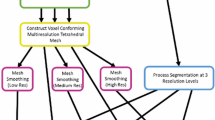Abstract
In this paper, we investigate the introduction of cortical constraints for non rigid inter-subject brain registration. We extract sulcal patterns with the active ribbon method, presented in [10]. An energy based registration method [7] makes it possible to incorporate the matching of cortical sulci, and express in a unified framework the local sparse similarity and the global “iconic” similarity. We show the objective benefits of cortical constraints on a database of 18 subjects, with global and local measures of the quality of the registration.
Acknowledgements
This work has been partly supported by the Brittany Country Council under a contribution to the student grant. Grant support for the acquisition of the data was provided by the GIS Project “cognition science”.
Access this chapter
Tax calculation will be finalised at checkout
Purchases are for personal use only
Preview
Unable to display preview. Download preview PDF.
Similar content being viewed by others
References
A. Caunce and CJ. Taylor. Using local geometry to build 3D sulcal models. Proc. IPMI, pages 196–209, 1999.
H. Chui, J. Rambo, J. Duncan, R. Schultz, and A. Rangarajan. Registration of cortical anatomical structures via robust 3D point matching. Proc. IPMI, pages 168–181, 1999.
L. Collins, G. Le Goualher, and A. Evans. Non linear cerebral registration with sulcal constraints. Proc. of MICCAI, pages 974–985. Springer, October 1998.
L. Collins, G. Le Goualher, R. Venugopal, A. Caramanos, A. Evans, and C. Barillot. Cortical constraints for non-linear cortical registration. Proc. VBC, pages 307–316, September 1996.
T. Cootes, C. Taylor, D. Hooper, and J. Graham. Active shape models-their training and application. CVIU, 61(1):31–59, 1995.
J. Gee, L. Le Briquer, C. Barillot, and D. Haynor. Probabilistic matching of brain images. In Bizais et al., editor, Proc. Information Processing in Medical Imaging, Brest, June 1995. Kluwer academic publisher.
P. Hellier, C. Barillot, E. Mmin, and P. Prez. An energy-based framework for dense 3d registration of volumetric brain image. In IEEE CVPR, pages 270–275, Jun 2000.
B. Horn and B. Schunck. Determining optical flow. Artificial Intelligence, 17:185–203, 1981.
F. Lachmann and C. Barillot. Brain tissue classification from mri data by means of texture analysis. In SPIE Press, editor, Spie Medical Imaging, pages 72–83, 1992.
G. Le Goualher, C. Barillot, and Y. Bizais. Modeling cortical sulci with active ribbons. IJPRAI, 8(11):1295–1315, 1997.
G. Le Goualher, E. Procyk, L. Collins, R. Venegopal, C. Barillot, and A. EvansG. Automated extraction and variability analysis of sulcal neuroanatomy. In IEEE TMI, 18(3):206–217, Mars 1999.
J. Maintz, MA. Viergever.-A survey of medical image registration. Medical Image Analysis, 2(1):1–36, 1998.
J.-F. Mangin, V. Frouin, I. Bloch, J. Regis, and J. Lpez-Krahe. From 3d magnetic resonance images to structural representations of the cortex topography using topology preserving deformations. Journal of Math. Ima. and Vis., 5(4):297–318, 1995.
J. Mazziotta, A. Toga, A. Evans, P. Fox, and J. Lancaster. A probabilistic atlas of the human brain: theory and rationale for its development. Neuroimage, 2:89–101, 1995.
M. Nagao and M. Matsuyama. Edge preserving smoothing. CVGIP, 9:394–407, 1979.
M. Ono, S. Kubik, C. Abernathey.-Atlas of the cerebral sulci.-Verlag, 1990.
D. Riviere, JF. Mangin, D. Papadopoulos-Orfanos, J. Martinez, V. Frouin, and J. Regis. Automatic recognition of cerebral sulci using a congregation of neural networks. In Proc. of MICCAI, 2000.
N. Royackkers, H. Fawal, M. Desvignes, M. Revenu, and JM. Travere. Morphometry and identification of brain sulci on three-dimensional MR images. Proc. IPMI, pages 379–380, June 1995.
S. Sandor and R. Leahy. Surface-based labeling of cortical anatomy using a deformable atlas. IEEE TMI, 16(1):41–54, 1997.
G. Szekely, Ch. Brechbhler, O. Kbler, R. Ogniewicz, and T. Budinger. Mapping the human cerebral cortex using 3d medial manifolds. In VBC, pages 130–144, 1992. SPIE.
J. Talairach and P. Tournoux. Referentially oriented cerebral MRI anatomy. Georg Thieme Verlag, New-York, 1993.
J.P. Thirion and A. Gourdon. The marching lines algorithm: new result and proofs. Research report 1881, INRIA, March 1993.
P. Thompson and A. Toga. A surface-based technique for warping threedimensional images of the brain. IEEE TMI, 15(4):402–417, 1996.
M. Vaillant and C. Davatzikos. Hierarchical matching of cortical features for deformable brain image registration. Proc. IPMI, pages 182–195, June 1999.
X. Zeng, L.H. Staib, R.T. Schultz, H. Tagare, L. Win, and J.S. Duncan. A new approach to 3D sulcal ribbon finding from MR images. MICCAI, pages 148–157, September 1999.
Author information
Authors and Affiliations
Editor information
Editors and Affiliations
Rights and permissions
Copyright information
© 2001 Springer-Verlag Berlin Heidelberg
About this paper
Cite this paper
Hellier, P., Barillot, C. (2001). Cooperation between Local and Global Approaches to Register Brain Images. In: Insana, M.F., Leahy, R.M. (eds) Information Processing in Medical Imaging. IPMI 2001. Lecture Notes in Computer Science, vol 2082. Springer, Berlin, Heidelberg. https://doi.org/10.1007/3-540-45729-1_32
Download citation
DOI: https://doi.org/10.1007/3-540-45729-1_32
Published:
Publisher Name: Springer, Berlin, Heidelberg
Print ISBN: 978-3-540-42245-7
Online ISBN: 978-3-540-45729-9
eBook Packages: Springer Book Archive




